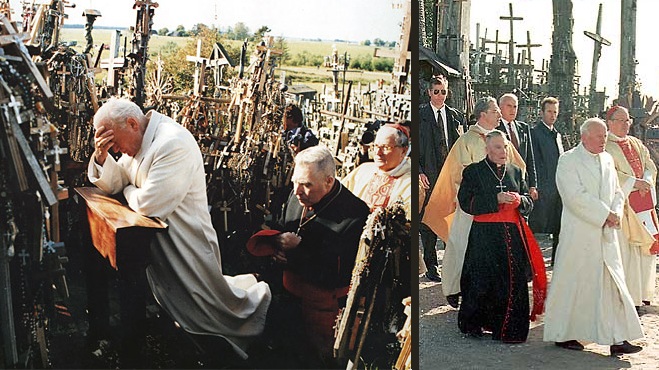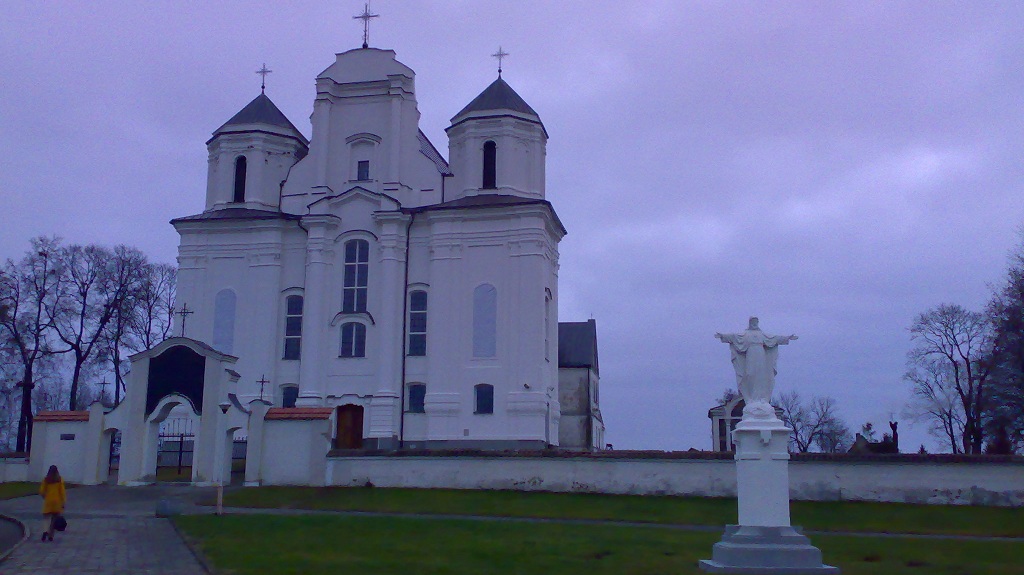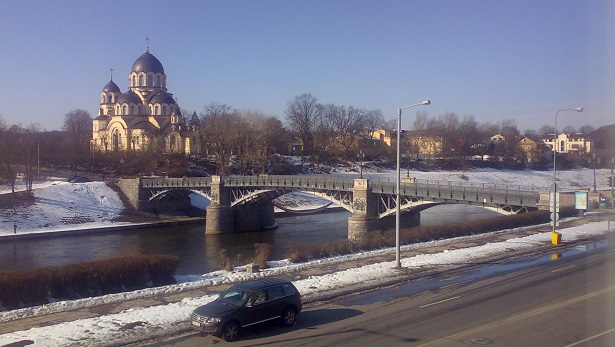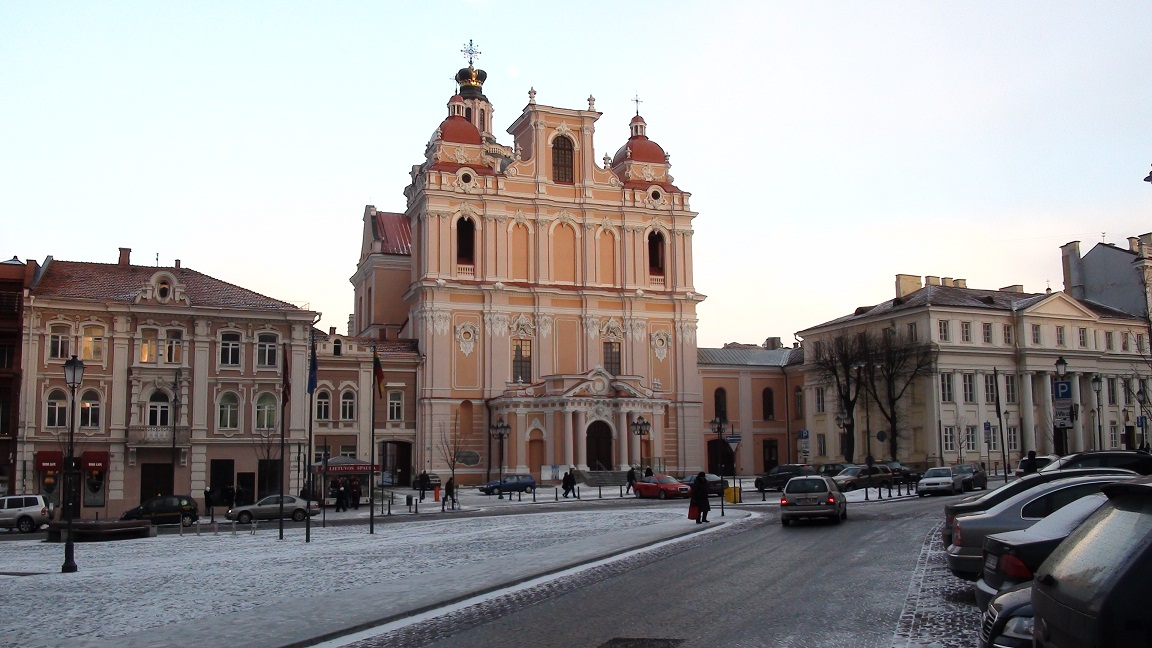Religious Sites in Lithuania: Introduction
Few countries could surpass Lithuania in size and lavishness of its churches if you take local population numbers into account. Furthermore, Lithuanian art of making elaborate crosses is inscribed in the UNESCO list of immaterial world heritage.
Nowhere this is felt more than in the Hill of Crosses (a unique-in-the-world site where millions of pilgrims have erected hundreds of thousands of crosses over more than a century). Arguably it is the most famous sight in Lithuania. A symbol of religion, anti-Soviet resistance and a powerful work of art all at once the Hill of Crosses impresses Christians and non-Christians alike.
View from one of the 'summits' of the Hill of Crosses. ©Augustinas Žemaitis.
Religiously however the center of Catholic life in Lithuania is in Šiluva. In this Samogitian village the Europe's first church-recognised apparition of Virgin Mary took place in 1608. The yearly celebrations (September 8th-16th) attract many thousands.
Almost every Lithuanian town and larger village have a Catholic church that feels far too massive for the settlement's population. This is because Catholicism always dominated the religious landscape (80%+ follows it) and there was no serious religious fragmentation for centuries. The older town and village churches (pre-1860) are typically smaller and wooden while the early 20th-century revivalist ones easily dwarf their surroundings in size. There is even a separate Lithuanian word meaning "Village with a Catholic church" (bažnytkaimis).
Rokiškis town church (1877) is considered among the best examples of Gothic Revival in Lithuania. ©Augustinas Žemaitis.
The most impressive collection of churches is in Vilnius Old Town where there are almost 30 such pearls of Gothic and Baroque. Most famous are St. Anne (for its exterior), Divine Mercy and the Gate of Dawn (both for miraculous paintings with worldwide following). Other boroughs of Vilnius also have a fair share of imposing churches (St. Peter and Paul being the most famous). So does the city of Kaunas.
In cities and towns one may also find Russian Orthodox churches. The largest and most important ones are once again in Vilnius where Holy Spirit church includes bodies of three Orthodox saints. Old Believer, Lutheran, Reformed Christian, Eastern Rite Catholic, Jewish, Muslim and Karaite religious buildings also exist, many of them predating the 20th century.
There is a long tradition in Lithuania of erecting crosses, chapels and chapel-posts (miniature chapels) at roadsides, cemeteries and courtyards. Countless of them were destroyed by the Soviet occupational power but many still remain. Some locations known as the holy places (šventvietė) became minor replicas of the Hill of Crosses.
See also: Religions in Lithuania, Christian holidays in Lithuania.

Map of main religious places and churches in Lithuania. Note: Lithuania has hundreds of beautiful churches and it is impossible to mark them all. ©Augustinas Žemaitis.
Hill of Crosses
The most important place of interest in the area is the Hill of Crosses north of Šiauliai. Visited both by pilgrims and irreligious tourists this place is a remarkable symbol of Lithuanian peaceful resistance to the Soviet occupation. People used to bring crosses to a hill once crowned by a medieval castle. The atheist Soviet government used to tear all the crosses down and persecute the pilgrims, but very soon the crosses would spring up again, restoring the number to hundreds and thousands.
This Virgin Mary statue (erected by a visitor in 1994) became popular for pilgrimage as evident by many small crosses hanging on the large crosses that surround it. ©Augustinas Žemaitis.
In 1990 when Lithuanian independence was restored 14 387 large crosses and 40 944 small crosses were counted, covering an area of 4602 square meters. By 2007 the number surpassed 200 000. In 1997 a Franciscan monastery was built next to the hill. The monastery chapel (open for visiting) has a large window with the hill visible in the background instead of altar paintings.
The atmosphere in the Hill of Crosses may be surreal. Thousands of large wooden crosses are used as platforms for many times that number of small ones, all of which beautifully chime in the wind. Most of them bear inscriptions with names of the people and their reasons for erecting the cross. There are crosses built by biker clubs, political parties, ordinary families, pilgrims from far away lands, priests and every other category of people you may imagine. They thank God or ask for his guidance, remember life-changing events, seek help for some particular groups of the population. The inscriptions are largely Lithuanian, but you may find those in countless other languages representing different Christian denominations. The crosses are eagerly erected up to this day as you can see in the recent dates inscribed on some of the crosses.
A part of the Hill of the Crosses in winter. In this season you may have the place all to yourself, meditate or pray with hundreds of thousands of little crosses chiming in the cold wind. ©Augustinas Žemaitis.
The tradition of erecting crosses here might have started under Imperial Russian rule in the mid-19th century. A legend tells that one person from Jurgaičiai promised God that he would build a cross on this hill in case his disease would pass. The disease passed and the man kept his promise - later to be followed by others. There are other stories, such as the one about a person whose daughter was ill and who received a vision that he should build a cross there. Whatever the reasons for its inception the place became an important pilgrimage site and erecting a cross here became a popular way to thank God.
The Lithuanian art of cross-crafting (kryždirbystė) is inscribed into the UNESCO list of immaterial world heritage. Not long ago most of Lithuania's roads were adorned by many large wooden crosses. Today there are few roadside crosses left but the Hill of Crosses is an important monument to this art. 50 of its crosses are regarded to be of major cultural significance.


Pope John Paul II visited the Hill of Crosses in 1993.
Šiluva Virgin Mary Shrine and Tytuvėnai Monastery
World’s second earliest Church-recognised apparition of Mary (after the Virgin of Guadalupe) took place in Lithuania, in the Samogitian village of Šiluva. In 1608 the Virgin appeared to various local people protesting the destruction of a local church.
The church has been more than rebuilt: a long rectangular Christian-themed plaza now dominates the village. At its northern end stands the 1786 Baroque minor basilica of Our Lady of Šiluva with its miraculous altar painting. At the opposite end, the 1924 chapel by Antoni Wiwulski (a genius of monolith architecture) marks the exact place of the apparition. It is surrounded by graves of notable Samogitians. 40 m tall and much less wide the obelisk-like square chapel is unusual in Christian architecture. The centerpoint of its interior is appropriately left for a statue of the Virgin (surrounded by the faithful from every side during the daily Holy Mass).
Main plaza of Šiluva with the chapel in the background. Statues of Virgin Mary and Pope John Paul II (who visited Šiluva in 1993), stone crosses and wooden figures surround it. ©Augustinas Žemaitis.
Each September 8th-16th the square itself becomes a large open-air church as tens of thousands of pilgrims arrive here from all over the world. Prior to the World War 2, massive processions used to depart from every Lithuanian town for a tiresome walk to Šiluva. Soviets persecuted this tradition, arrested local priests and blocked roads, yet Šiluva remained the religious heart of Lithuania to this day.
Tytuvėnai town, 8 km north of Šiluva, is home to a 17th-18th century Bernardine monastery. Closed in 1863 by the Russian Empire it has been long abandoned, retaining the original atmosphere. In the cloister, you may easily imagine monks praying at the centuries-old murals and reliefs that adorn massive arcaded walls which hide the modern-era life outside. The monastery also includes a still-used lavish church, a partly repaired former monk dormitory, and the Holy Stairs chapel (1775) with stairs that should be both ascended and descended kneeling.
The cloister of Tytuvėnai monastery. ©Augustinas Žemaitis.
Šiluva and Tytuvėnai may be explored as a detour while traversing the Vilnius/Kaunas-Klapėda highway. It may also be easily combined with a visit to the former centers of Samogitia Kražiai, Varniai and Rietavas, with Kražiai being some 30 km west of Tytuvėnai and others further on.
Historical Heartland of Samogitia: Kražiai, Varniai, Rietavas
In three small towns of central Samogitia, several out-of-scale buildings divulge their past importance. These are Kražiai, Varniai, and Rietavas, the political, religious, cultural and educational centers of western Lithuania in the 15th-19th centuries.
Kražiai, the original capital of Samogitia (1416-1464). The 1762 Late Baroque church here became notable again in 1893 when a mass of people protested the Russian Imperial decision to close it down. This led to a Cossack massacre of the unarmed Lithuanian peasants (9 killed, 53 injured, 150 arrested) which triggered an outrage in the religious 19th century Christian world that in turn saved the church from demolition (but not closure). Only a belfry remains from a much older wooden church (established in 1416). Kražiai’s third church was at the former Jesuit college. Today’s sleepy village hardly reminds an education center but it attracted many students from afar in 1614-1844. Recently restored former dormitory (bursa) is a witness of this era.


Church of Kražiai. ©Augustinas Žemaitis.
In 1464 the center of Samogitian diocese was moved 28 kilometers west to Varniai. Two churches (one brick, one wooden) remind of that town former importance, as does the recently rebuilt 53 m tall tower of former priest seminary (1770), now home to the diocesan museum.
Baroque St. Peter and Paul church with 11 altars (left) and the priest seminary tower (right) in Varniai. ©Augustinas Žemaitis.
Rietavas, 33 km further west, is centered around a large neo-Romanesque church built in 1873. This was the golden age of the Oginskis family. Technology-loving dukes of Rietavas also constructed Lithuania’s first telephone line (1882) and power station (1892), established a famous music school in what were the last years when manors rather than cities were the source of progress and culture in Lithuania. The towered Oginskis Palace did not survive the trials of history, but other buildings of the manor did. Today Rietavas is also known for its bustling bazaar-like market which occupies a disused airfield every Sunday morning, attracting buyers and sellers from all over Samogitia and beyond.
Kražiai-Varniai-Rietavas route may be explored as a detour while traversing the Vilnius/Kaunas-Klapėda highway. It may also be easily combined with a visit to Šiluva Virgin Mary Shrine and Tytuvėnai Monastery, both some 30 km east of Kražiai.
Vilnius Churches Outside Old Town
The following are several of the most iconic Christian churches outside the Vilnius Old Town.
*Church of Saint Peter and Saint Paul (Antakalnis borough, 1675) has the prettiest interior in Vilnius. It includes over 2000 white statues and bas-reliefs made to reflect the idea that life is a theater. Many Biblical scenes are depicted here in this uniform way.
*Church of the Finding of the Holy Cross(Verkiai borough, 1772, Baroque) was once built outside the city limits. It is famous for its Via Dolorosa, an 18th-century system of forest paths with chapels reminding of various events during the passion of the Christ. Unfortunately, Soviets destroyed 31 out of 35 stations in 1962. However, now the chapels are rebuilt and the several kilometers long route through local woods makes a good hike.
*Church of Blessed Jurgis Matulaitis (Karoliniškės borough, see “Soviet districts“) was started in 1991 and frankly never completed. It is consecrated now and the Holy Mass is celebrated, but without the envisioned tower this brutalist building looks blunt. It is a good reminder of the early independence era when the Roman Catholic church used the newly gained religious freedom to build new churches in formerly „atheist“ Soviet boroughs and towns. Construction and real estate was unbelievably cheap at the time, but not for long. Therefore many early 1990s church designs had to be simplified or canceled altogether. Other 1990s Catholic churches in Vilnius (St. John Bosco in Lazdynai and St. Joseph in Pilaitė) are smaller. Contemporary LDS (Mormon) ward in Baltupiai, New Apostle Church in Rasos, and Tikėjimo žodis in Pilaitė signifies that 1990s religious freedom also brought in new denominations.
Church of Blessed Jurgis Matulaitis in Karoliniškės. ©Augustinas Žemaitis.
*The Russian Orthodox churches were built in every new borough of Vilnius in the 19th century under the rule of the Russian Empire. The Constantine and Michael Church (commonly known as Romanov church as it was constructed for the 300 years jubilee of the Romanov dynasty in 1909) is in Naujamiestis, the Znamenskaya Church (1903) in Žvėrynas and the beautiful Saint Alexander Nevsky church (1865) in Naujininkai . Šnipiškės has the Saint Michael Russian Orthodox church (1895) at the main Kalvarijų street, surrounded by single floored buildings once meant for teaching purposes. All these are built on Neobyzanthic style. There are more Orthodox churches and chapels dating to this era but the aforementioned four are the largest.


Znamenskaya Russian Orthodox church in Žvėrynas on the other side of the contemporary Žvėrynas bridge (1906). ©Augustinas Žemaitis.
For the locations of the churches see the maps of particular districts.





